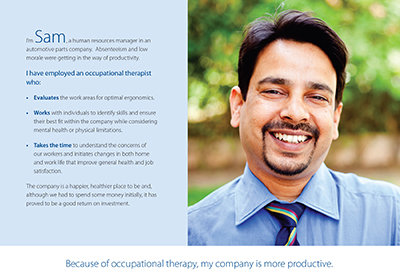We encourage you to share this information with family and friends.
Aboriginal Health
There is growing recognition of the need for improving the health of First Nations, Inuit and Métis in Canada. The health status of Aboriginal Peoples is below the national average.
Occupational therapy service can influence the health, well-being and occupational justice of First Nations, Métis and Inuit people. Occupational therapists understand the dynamic relationship between the person, occupation, and environment. Occupational therapists provide effective, compassionate, culturally safe and collaborative services with First Nations, Métis and Inuit people.
Talk to an occupational therapist to help:
- Adapt activities
- Develop individualized educational and health plans
- Work with the community
- Expand health literacy
Resources
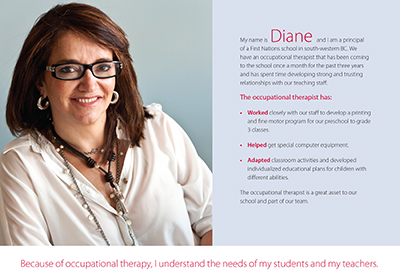
Alzheimers
Alzheimer's disease is a fatal, progressive and degenerative disease that destroys brain cells. It is the most common form of dementia, accounting for 64 per cent of all dementias in Canada. Symptoms include difficulty remembering things, making decisions and performing everyday activities. These changes can affect the way a person feels and acts. There is currently no way to cure the disease, but research is improving the way we provide care. Currently there are 500,000 Canadian living with Alzheimer’s disease or a related dementia, 72% are women.
Occupational therapists help clients and families understand the impact of Alzheimer’s disease on the person’s day-to-day function. The occupational therapist works with clients to develop ways to compensate for limitations and maintain independence.
Talk to an occupational therapist to help:
- Facilitate opportunities for independence and personal control,
- Develop a schedule for regular daily activities,
- Adapt and modify homes,
- Assist family members and caregivers.
Resources

Arthritis
Arthritis is one of Canada’s most common chronic conditions. With over 100 different forms, arthritis can strike anyone at any time, regardless of age, physical condition, culture, gender, often with devastating and debilitating effects. People living with arthritis are burden everyday with pain and disability, including joint pain, stiffness and swelling. There is no cure for arthritis only treatment. The impact of arthritis on our economy in terms of healthcare cost and loss of productivity is currently estimated at $33 billion a year and is expecting to double within 15 years.
Occupational therapy recognizes that everyday occupational engagement influences mental and physical health. Occupational therapists believe that occupational performance, organization, choice and satisfaction are determined by the relationship between persons and their environments. Occupational therapists approach mental health with this unique perspective that considers a person’s needs within context of family and community.
Talk to an occupational therapist to help:
- Evaluate and develop strategies to manage self-care, childcare, home management, work and leisure activities.
- Identify and schedule priorities in work, home and leisure to save time, energy and reduce fatigue.
- Suggest devices, postures and techniques to help decrease inflammation, deformity and maintain function for people with arthritis.
- Teach strategies to reduce joint stress, decrease daily pain and conserve energy.
- Advocate for clients for flexible work schedules and tasks with employers to allow to plan for changes in function that come with arthritis.
Resources

Autism
Autism Spectrum Disorder (ASD) is the most common developmental disability and neurological disorder affecting people across their lifespan, although usually first diagnosed in children. According to Autism Speaks Canada, an estimated 1 out of 42 boys and 1 in 189 girls are diagnosed with autism.
ASD presents differently in every individual, impacting all aspects of an individual’s development and occupational performance, including their ability to perform activities of self-care / daily living, and to participate in productive work (and education for children) and leisure and recreation activities, as well as overall, their ability to communicate and socially participate.
Occupational therapists use their knowledge of sensory processing, emotional and behavioural regulation, oral/fine/gross motor development and task analysis to support learning and participation. Occupational therapists bring a unique and comprehensive perspective in the treatment of persons with ASD, in that they are highly educated and experienced to evaluate and provide intervention, both direct treatment and consultation to families, educators and caregivers, in the areas of physical, sensory processing, and social – emotional health in all environments of a person with an ASD.
Talk to an occupational therapist to help:
- Help clients achieve optimum independence and well-being, considering their personal goals, interests and motivation.
- Assess skills and create intervention plans to promote participation of the individual within their daily routine.
- Provide developmentally appropriate goals related to play, social interactions, attention, motor skills, self-care, etc.
- Support learning and participation through their knowledge of sensory processing, emotional and behavioural regulation, oral/fine/gross motor development and task analysis.
- Recommend modifications or accommodations to activities and the environment that help people with ASD participate in activities at home, at school and in the community.
- Assess driving capacities, develop vocational skills, and explore independent living options
- Contribute to interprofessional teams which include psychologists, psychiatrists, behavioural therapists, early interventionists, social workers, educators, vocational counsellors and life skills workers.
Resources
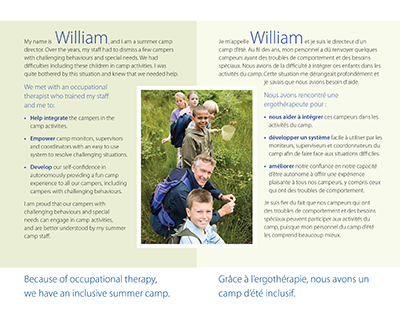
Cancer
Cancer treatments can have an impact on quality of life and participation in meaningful activities. This can include the experience of multiple physical, psychological and cognitive symptoms such as fatigue, pain or discomfort, decreased mobility and physical functioning, negative self-esteem and self-image, altered capacity to concentrate on tasks and fear of risk for cancer recurrence. Clients undergoing cancer treatments may also experience a change in their family roles, employment and recreation and may have difficulty navigating the complex health care system.
Occupational therapists address the diverse and unique needs of cancer survivors. Occupational therapists use client-centered and holistic approaches to address the client’s physical, social, emotional, and spiritual needs and goals. Treatments are designed to make use of the client’s available strengths and resources, and are adapted to the client’s changing abilities and goals to get them back to doing the activities they need to, want to, or are expected to do.
Talk to an occupational therapist to help:
- Work with clients to promote their participation in activities of daily living by addressing emotional concerns (including stress and anxiety) and physical changes or limitations
- Provide education for energy conservation and relaxation techniques
- Make suggestions to adapt activities, or alter the environment, to support the client’s needs
- Engage and empower survivors to manage their health with the appropriate support
- Connect clients to available resources
Resources
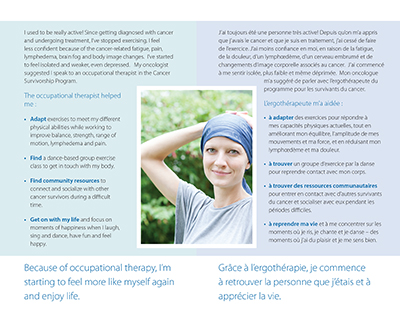
Cerebral Palsy
Cerebral palsy (CP) is a broad term used to describe a group of chronic disorders affecting body movement and muscle coordination. This appears in the first few years of life and generally does not worsen over time; it is non-progressive. The effect of cerebral palsy can vary from individual to individual. Some people may appear to have no obvious effects while others may be non-speaking, use mobility devices or require assistance with activities of daily living. According to Statistics Canada, over 40,000 Canadians are currently living with cerebral palsy.
Occupational therapists help clients, families and organizations (such as schools and employers) understand the effects of cerebral palsy on day-to-day function. The occupational therapist works with clients to develop ways to compensate for any perceived limitations and enhance independence.
Talk to an occupational therapist to help:
- Assess skills, interests, values, and strengths in order to help identify an appropriate career path,
- Facilitate opportunities for independence and personal control while supporting self-esteem,
- Address barriers to participation in active and healthy occupations by advocating for safe and accessible environments that support occupations for all Canadians,
- Help maintain social connectedness, adapt to and manage health/ability challenges as they arise,
- Help engage in occupations that allow self-expression, opportunities to learn, and promote feelings of belonging and contributing.
Resources
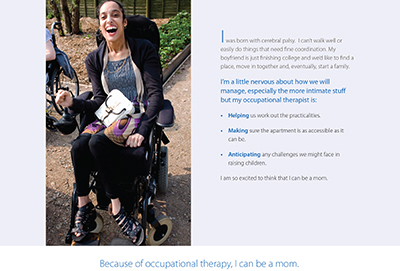
Concussion
A concussion is a brain injury caused by excessive, rapid movement of the brain inside the skull. Concussion can result from a direct blow to the head, face or neck or an indirect hit or injury that has enough force to jostle the brain. A concussion can result in and can include a range of physical (e.g., headache, nausea, dizziness), cognitive (e.g., decreased attention, slowed reaction time, memory difficulties etc.), emotional/behavioural (e.g., irritability, sadness, anxiety etc.) and sleep-related (e.g., increased sleep, difficulty falling asleep, difficulty staying asleep etc.) Signs and symptoms can be immediate or delayed (e.g. hours, days etc.).
Although there are typical signs and symptoms, each person may experience a concussion differently.According to Statistics Canada, over 94,000 concussion and related brain injuries are reported each year. Nearly a third of reported concussions occurred among 12 to 19 years. Sixty percent of those concussions are sports-related. Every year, a large number of concussions are not reported.
Occupational therapy recognizes that everyday occupational engagement influences mental and physical health. Occupational therapists believe that occupational performance, organization, choice and satisfaction are determined by the relationship between persons and their environments. Occupational therapists approach concussions with this unique perspective that considers a person’s needs within context of family, daily activities and community.
Talk to an occupational therapist to help:
- Work with clients and their families to identify the occupations and activities that are important for family, personal and work/school life
- Help the client return to daily activities (school, work, sports and leisure, social life, etc.) safely and in a way that would allow the client to recover from their concussion.
- Help clients rebuild confidence in their daily lives after a concussion.
- Provide education for energy conservation and relaxation techniques.
- Provide recommendations and build strategies for communities, stakeholders and decision makers on the development of concussion education and rehabilitation programming.
Resources

Criminal Justice
The law affects nearly every aspect of our lives. We have laws that regulate common activities such as driving a car and renting an apartment and laws that deal with crimes such as robbery and other threats and challenges to society. The criminal justice system represents any interaction with the justice system from police officers, court rooms and prisons to state run rehabilitation programs, probation services and half way houses.
Occupational therapists work with those involved in the criminal justice system. They may work with individuals to help identify strengths, values, interests, resources and challenges in order to implement plans that address family commitments, employment and leisure activities.
Talk to an occupational therapist to help:
- identify the occupations and activities that are important
- set realistic short and long term goals
- Advocate for clients
- clients engage in appropriate activities
Resources
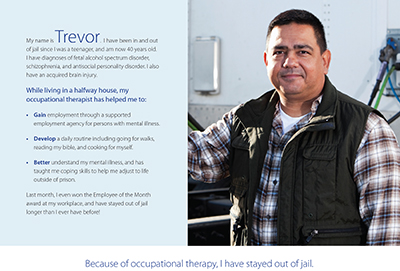
Emergency
The emergency department is a medical treatment facility that specializes in emergency medicine, usually located in a hospital or primary care center. The department provides initial treatment for a variety of illnesses and injuries, some of which may be life-threatening and require immediate attention.
According to the Canadian Institute for Health Information (CIHI), more than 10 million emergency department visits were reported in 2013-2014. One million of which were hospitalized after their initial assessment. Emergency departments cost Canadian hospitals approximately $1.8 billion a year.
As part of an interprofessional health team, occupational therapists have a vital role in the emergency department. Occupational therapists are uniquely positioned to provide assessments and rehabilitation as well as focus on the quality of care received. Occupational therapists can be directly involved in several aspects of patient assessment at emergency department as well as helping in making complex decision on admissions and discharges, eliminating unnecessary admissions to the hospital.
Talk to an occupational therapist to help:
- Provide assessment and recommendation on admissions
- Identify and recommend appropriate adaptive equipment and services
- Connect the client to primary care and community services
- Advocate for the client and their individual needs
- Promote occupational therapy’s role within the emergency department
Resources

End of Life Care
End-of-life care aims to relieve distress that is often associated with death and improve the quality of life for both those diagnosed with an advanced or terminal illness and their loved ones. End-of-life care is appropriate for individuals of any age and/or their families, who are living with or at risk of developing a life-threatening illness. Statistics Canada estimates that approximately 247,000 deaths occur each year. It has been proposed that each death can affect the wellbeing of five other people. This means that every year, death and dying can potentially affect over 1.4 million Canadians.
At end-of-life, occupational therapy values client-centered and holistic approaches that involve reframing and tailoring interventions to adapt to the client’s changing goals, as well as addressing the client’s physical, social, emotional and spiritual needs and occupational pursuits.
Talk to an occupational therapist to help:
- Support and educate clients, their families, caregivers, other health care professionals and policy makers about the importance of remaining engaged in occupations and activities that are valued and provide a sense of purpose.
- Work with clients to address activities of daily living, psychological and emotional issues (including stress and anxiety), occupations, splinting and positioning, energy conservation, relaxation techniques, seating and mobility, comfort, adaptive and assistive equipment.
- Advocate for clients to die with dignity, free of pain, surrounded by their loved ones, in a setting of their choice.
- Promote and engage in occupational therapy- specific and interdisciplinary research that expands the knowledge base for end-of-life care in Canada, including the development of end-of-life care strategies or programs.
Resources

Fall Prevention
Falls are the most common preventable injury in Canada. According to Statistics Canada, 63% of seniors, 50% of adolescents and 35% of working-age adults have been injured by falls. Sports related activities are the main cause of injury by falls for adolescents. Older adults’ falls often result from tripping, stumbling or walking or doing household chores.
Occupational therapists approach fall prevention by addressing personal, environmental and behavioral factors which influence people’s participation in activities at home and in the community. Occupational therapists work with other professionals to assess and help clients develop the skills needed to engage in healthy and meaningful lives, including preventative education.
Talk to an occupational therapist to help:
- Develop simple and elegant solutions to prevent falls, such as using sand on slippery surfaces, ensuring stability of railings and teaching client how to walk with a cane.
- Work with employees who have experienced injury and their employers to develop a daily schedule of graded, meaningful activities that may reduce the risk of (re)injury, increase physical fitness.
- Provide recommendations and build strategies for communities, stakeholders and decision makers on the effectiveness of innovative home or community support options.
- Help clients rebuild confidence in their daily lives after a fall.
Resources

Mental Health
Mental health problems can affect people of all ages, cultures, education and income levels. Mental illness varies from person to person and can include depression, anxiety, psychosis, bipolar disorder, and post-traumatic stress and personality disorders. According to Health Canada, nearly 6.7 million people have been diagnosed with a mental illness. This represents a total burden of nearly $51 billion on the Canadian economy.
Occupational therapy recognizes that everyday occupational engagement influences mental and physical health. Occupational therapists believe that occupational performance, organization, choice and satisfaction are determined by the relationship between persons and their environments. Occupational therapists approach mental health with this unique perspective that considers a person’s needs within context of family and community.
Talk to an occupational therapist to help:
- Help replace unhealthy activities, such as substance abuse, with healthy, meaningful activities.
- Assess skills, interests, values, and strengths in order to help clients maintain, modify or find appropriate employment.
- Implement activities that teach valuable skills e.g. social skills training with a peer support group.
- Help structure lives and organize daily activities so that clients can balance everything they want, need or are expected to do.
Resources

Older Adults
Older adults are the fastest growing sector of our population, with nearly 5 million people aged 65 and older, according to Canadian statistics. A large majority of older adults live in private residences, and report their health as very good or excellent. However, the incidence of chronic illness increases with age, and one in ten people aged 75 and older require assistance with basic activities of daily living. Older adults play key roles in communities. Such roles may include volunteering, working, sharing knowledge and experiences, and caregiving.
Occupational therapists work with older adults, including those with disabilities, to age in a place of their choosing by building relationship with the older adults, their families, caregivers, and community stakeholders. Occupational therapists advocate for and help plan safe, accessible, affordable, and age-friendly living options and community environments. Occupational therapists work with other professionals to assess and help clients develop the skills needed to engage in healthy and meaningful lives.
Talk to an occupational therapist to help:
- Facilitate opportunities for independence, personal choice and social connectedness,
- Develop residential care schedules that keep people meaningfully occupied,
- Link communities with researchers to evaluate the effectiveness of innovative home or residential care support options,
- Develop tools and resources that contribute to active living for all older adults,
Resources

Older driver safety
Older adults represent the fastest growing portion of the driving population, with roughly 2.7 million drivers over the age of 65 on Canadians roads today. Older drivers have long been believed to be the safest and most cautious drivers on the road, taken into account their experiences, sheer number of kilometers and driving years behind their safety belts. Regardless of this experience, evidence proves that older drivers have more collisions per kilometers driven that any other group. Older drivers injured in car collisions are slower to recover from injuries or are more likely to die to these injuries.
Occupational therapists know that driving represents autonomy and independence, and contributes to quality of life and well-being. Driving allows people to get to where they need and want to go to participate in the daily occupation of life. Occupational therapists have a long history of working on strategies to help drivers reduce injury and promote safe-driving practices to keep this expanding group of drivers actively engaged in their communities. Occupational therapists believe that driving is a privilege but mobility is a right.
Talk to an occupational therapist to help:
- Evaluate your driving, develop programs to improve safe driving, or help find alternative transportation .
- Ensure your clear line-of-sight over the steering wheel.
- Check the space between the front air/bag/steering wheel and the driver’s breastbone.
- Provide strategies to help people with driving safety and driving retirement.
- Adjust and ensure proper seat belt use and fit
- Recommend adapted equipment to enhance your driving practice.
Resources
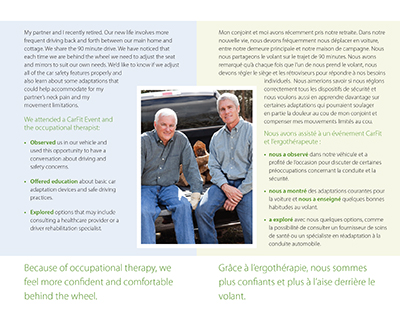
Post Traumatic Stress
Post-Traumatic Stress Disorder (PTSD) and Operational Stress Injuries (OSI) are a complex conditions caused by traumatic and extremely distressing events such as crimes, natural disasters, accidents, war or other threats to life. Nightmares, flashbacks, or overwhelming and recurring thoughts of the event can interfere with normal life for months.
PTSD and OSI can make people feel very nervous or ‘on edge’ all the time. Many feel startled very easily, feel irritable, have a hard time concentrating, or have problems eating or sleeping well. At the opposite, some people feel numb and detached. They may feel like things around them aren’t real, feel disconnected from their body or thoughts, or have a hard time feeling emotions. For some people, alcohol or drugs is the only way they found to cope with PTSD and OSI.S
Occupational therapists work with individuals to help identify strengths, values, interests, resources and challenges in order to implement plans that address family commitments, employment and leisure activities. Occupational therapy looks beyond the physical and mental disability and works with their clients and their family to help them engage in the meaningful activities of their lives.
Talk to an occupational therapist to help:
- Work with clients and their families to identify the occupations and activities that are important for family, personal and work life.
- Work with the client to better understand the impact of mental health problems.
- Help to plan, initiate and track short and long term goals that enable participation in those activities.
- Perform assessments to help understand specific challenges (concentration, attention, anxiety, impulsivity, divided attention).
- Teach practical, non-pharmaceutical ways of coping with adverse symptoms e.g. stress, pain, and sleep disruption.
- Use “hands on” approaches by: going to the individual’s home or workplace, meeting with the individual’s family and/or employer to facilitate engagement in target occupations.
Resources

Primary Health Care
Primary health care is usually the first place people go when they need health advice or care. Essentially, primary health care refers to an approach to health and a spectrum of services that includes all health services used in front lines by the population to address their health concerns. The goal of primary health care is to provide preventative services that extend beyond tradition health care.
Occupational therapists use their expertise and full scope of practice to improve client health and participation in daily activities. Occupational therapists act as primary care practitioners or health promotion experts, providing case management, chronic disease management, injury prevention techniques and caregiver education, for example. Their intervention can also focus on a health crisis or to prevent hospitalizations, shorten hospital stays and provide community or caregiver support.
Talk to an occupational therapist to help:
- Collaborate with interprofessional health care teams to provide a holistic assessment of a client’s needs
- Promote health and prevent illness and injury through health promotion and health literacy
- Teach and support family members and caregivers to help minimize their risk of injury, manage caregiver stress, and to find balance in life
- Address the current gaps and challenges in health care in Canada and provide solutions for changing health service needs
Resources
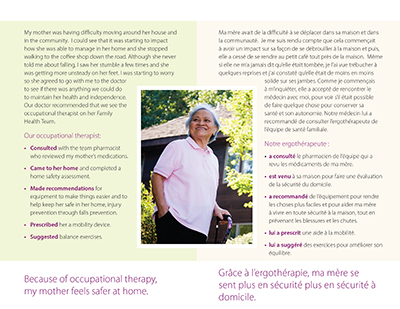
Social Inclusion
Social inclusion is a concept that aims to ensure that all people have access to the same rights, services and benefits as well as access to employment and work, income and economic resources, material resources, education and skills, health, housing, social resources, community resources, and personal safety. Social inclusion recognizes and values diversity, by focusing on people’s sense of belonging and ensuring social equality and participation. Social inclusion can impact the delivery of national, regional and local programs and services to meet the needs of a diverse clientele.
Occupational therapists have the knowledge and skills to identify factors that allow people to engage in daily activities and to facility the removal of barriers to participation. Occupational therapists strive to support individuals to realise their potential by enabling them to participate in and contribute to society.
Talk to an occupational therapist to help:
- develop policy and programs that are founded on the principles of social inclusion
- help modify teaching strategies to include more verbal support, problem solving and videotaped instruction for clients with a variety of needs
- collaborate with stakeholders such as national and regional jurisdictions, professional associations, health and human service organizations and communities to promote social inclusion in programs and services in order to promote social inclusion
- promote understanding of the relationship between social inclusion, occupational engagement and health and well-being
- educate general public, services providers and decision makers with social inclusion resources
Resources

Spinal Cord
Spinal cord injuries affect the spinal cord’s ability to send and receive messages from the brain which results in a loss of function and sensation. Spinal Cord Injuries can occur following a traumatic event or be the consequences of a disease.
Spinal Cord Injury Canada reported that 51% of current spinal cord injury result from accident, while 49% are caused by disease. Spinal Cord Injury Canada estimates that there are over 86,000 people living with spinal cord injury in Canada with 4,300 new cases each year. The annual cost of spinal cord trauma in Canada is approximately $3.6 billion of which $1.8 billion are direct health care costs.
Occupational therapists assess physical and cognitive function and provide skills training for activities of daily living from self-care to getting around your home and community. Occupational therapists can suggest equipment and assistive technologies to compensate for impaired motor function. Occupational therapists strive to support individuals to realise their potential by enabling them to participate in and contribute to society.
Talk to an occupational therapist to help:
- Address goals related activities of daily living such as self-care, work, and leisure.
- Assess individual needs for equipment and assistive devices.
- Recommend home modifications and adaptive equipment.
- Assist and navigate the system to obtain funding for equipment and services and help ensure that all of the client’s needs are met.
- Provide psychosocial support to help the client adapt to their new abilities and lifestyle.
- Educate client regarding self-care and exercise to help minimize secondary complications.
Resources
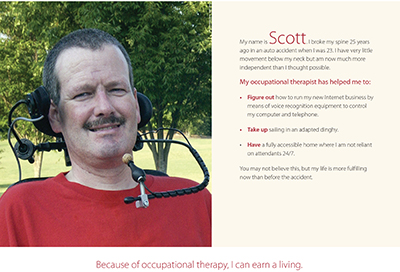
Stroke
A stroke is a sudden injury to part of the brain caused when blood flow in an artery stops. Stroke deprives areas of the brain of oxygen and nutrients, which damage functions and abilities. Stroke remains a serious health issue that can affect Canadian and their loved ones of all ages.
According to the Heart and Stroke Foundation of Canada there are an estimated 50, 000 people who sustain a stroke in Canada every year, or one every ten minutes. Stroke is the third leading cause of death in Canada. Conference Board of Canada estimates that heart disease and stroke costs the Canadian economy more than $20.9 billion every year in medical and hospitals cost as well as a lost in wages and productivity.
Occupational therapy is a client-centered profession that uses meaningful activities across the spectrum of physical and mental domains to reduce limitations after stroke. Occupational therapists help stroke survivors through all aspects of rehabilitation, including prevention, assessment and interventions. Occupational therapy focused on improving personal activities of daily living after stroke can improve performance and reduce the risk of deterioration in these abilities.
Talk to an occupational therapist to help:
- Assess the clients after stroke based on individual, social and environmental factors
- Recommend modifications or accommodations to activities and the environment that help people surviving with stroke participate in activities at home, at school and in the community
- Evaluate driving, develop programs to improve safe driving, or help find alternative transportation
- Address barriers to participation in active and healthy occupations by advocating for stroke related resources for all Canadians
Resources
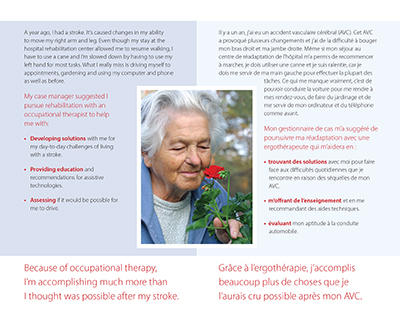
Substance Use
Substance use arises when people engage in an excessive pattern of using alcohol or mood-altering substances from illicit drugs to pharmaceuticals. An individual with a substance abuse problem chooses occupations that inevitably will have a negative impact on their physical, mental and social health.
According to the Canadian Centre on Substance Abuse, the social cost of substance abuse in Canada is estimated to be $39.8 billion and this includes the burden on the health care and law enforcement, loss of productivity in the workplace and at home due to premature death and disability.
Occupational therapists work with clients struggling with substance abuse issues. They may work with individuals to help identify strengths, values, interests, resources and challenges in order to implement plans for recovery. Occupational therapists believe that occupational performance, organization, choice and satisfaction are influenced by the relationship between personal and environmental factors. Occupational therapists approach substance abuse with this unique perspective that considers a person’s needs within the context of their family and community.
Talk to an occupational therapist to help:
- Discuss and identify the negative effects of a substance abuse pattern in the client’s life.
- Establish more satisfying and meaningful patterns of time use and create opportunities for self-discovery.
- Work with clients and their families to identify the occupations and activities that are important for family, personal and work life.
- Help replace unhealthy activities with healthy, meaningful activities.
- Help to plan, initiate and track short and long term goals that enable participation in other
- Advocate for federal, provincial and territorial governments’ investment in comprehensive substance use programs, legislation and policies to prevent and reduce substance abuse.
Resources
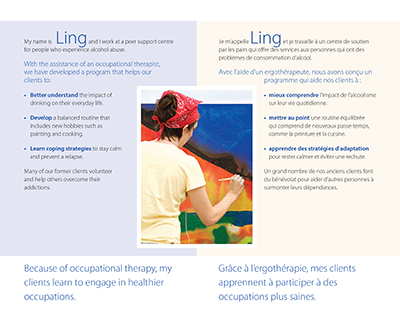
Occupational Therapy and Suicide Prevention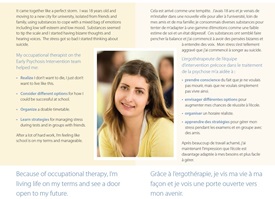
Suicidal thoughts and behaviors can affect people of all ages, cultures, education and income levels. Suicide or suicidal behaviors differ from person to person, but are often predicated by overwhelming feelings of hopelessness and helplessness.Occupational therapists routinely interact with clients about intimate details of their lives, and so are positioned to detect and respond to a risk of suicide in any practice setting. Occupational therapists approach health and wellness perspectives that consider a person’s needs within the contexts of family, community, and daily activities.
Talk to an occupational therapist to help:
- Identify the occupations and activities that make your life meaningful
- Plan, initiate and track short and long term goals that enable participation in those activities.
- Address possible risk factors for suicide
- Connect with a network of community supports
- Structure and organize daily activities to balance everything you want, need or are expected to do
Resources:
Universal Design
Universal design is a way to create products and environments that are more usable by everyone, regardless of age or ability. Universal design can be defined as the design of products and environments to be usable by all people, to the greatest extent possible without the need for adaptation or specialized design. In this definition the needs of persons with wide ranges of cognitive, visual, hearing, mobility and agility functions are taken into account as well as the needs of persons of various heights, widths and ages. Universal design is important to the design of environments such as houses, office buildings, hotels, restaurants, parks, streetscapes, urban planning, swimming pools, trails, historic attractions, museums, exhibits, auditoria, web sites, communication, product design, services and policies.
Occupational therapists have the knowledge and skills to be experts in universal design. Universal design contributes to health and well-being by enabling engagement in self-care, productivity and leisure. Occupational therapy in Canada is based on a model of practice that recognizes the interaction between occupation and the social, cultural, physical and institutional environment.
Talk to an occupational therapist to help:
- collaborate with stakeholders such as national and regional jurisdictions, professional associations, health and human service organizations and communities to promote implementation and evaluation of universal design principles for built environments, materials and tools
- promote the understanding of the relationship between engagement in healthy and accessible environments, occupational engagement and health and well-being
- continue professional education and practice resources to support occupational therapists understanding and use of universal design principles
- educate consumers and decision makers with evidence-based universal design resources
- collaborate in research to promote universal design for occupational engagement
Resources

Workplace Health
Occupational therapists are experts in ergonomic design and in the prevention of repetitive strain and other injuries in the workplace. Occupational therapy can help Canadians overcome many challenges at work by improving skills for self-management of chronic diseases, for managing chronic pain, and for managing depression and other mental health issues, all of which are essential for a healthy and productive workforce.
Talk to an occupational therapist to help:
- Returning to work after injury
- Depression or other mental health issues at work
- Work-life balance
- A chronic condition while continuing to work
Resources
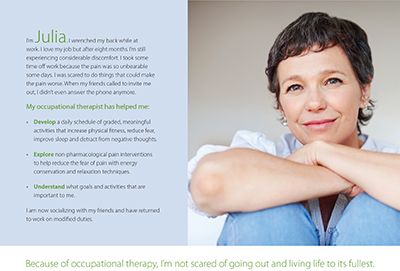
Workplace Mental
There is increasing evidence that absenteeism, productivity and morale are intricately linked to the health of employees. Research concludes that every year, mental health issues cost Canada’s employers billions of dollars in lost productivity. As well, employers who offer programs to support employees' mental health report substantial positive results for individual employees’ performance. Occupational therapists recognize that the health of the employee and the work environment are determined by a range of interacting factors. The choice, performance, organization and satisfaction in occupations are influenced by the relationship between people and their environment. Occupational therapists offer solutions to workplace mental health issues through programs and activities that can include nutrition and wellness, stress management, counseling, health and safety policies and life skills training.
Talk to an occupational therapist to help:
- Work with clients to identify goals, aspirations, lead their care, and work towards recovery
- Work with the client to better understand the impact of mental health problems.
- Work with the client to better understand the impact of mental health problems.
- Assess skills, interests, values, and strengths .
- Implement activities that teach valuable skills e.g. social skills training with a peer support group.
- Address barriers to mental health by creating work environments that facilitate meaningful occupation.
Resources
